Ellis Island Initiative: Shifting the Immigration Narrative through Pragmatic Community Engagement
One of the most volatile and divisive political issues in the runup to the 2024 elections was the sudden increase in the number of asylum seekers and new immigrants. Too often, political leaders who might be expected to lead on immigration tried to duck the question, or even fed into the anti-immigrant rhetoric. New York City Mayor Eric Adams, in a much-repeated comment, called the issue a “crisis” that would “destroy” New York City.
The Ellis Island Initiative strove to craft a different approach, one that has resonance and holds lessons for moving forward on immigration issues today. Focusing on suburban and rural, politically moderate and sometimes conservative parts of New York State—across upstate, the Hudson Valley, and Long Island—the Ellis Island Initiative strategy sought to bring together a broad, mostly non-immigrant group of local business, labor, faith, and community leaders to hammer out pragmatic approaches to the immediate issue of integrating these asylum seekers. In six areas across the state, the Initiative brought together local leaders – a combination of business and labor representatives who could address concerns of both employers and longstanding working-class residents; faith and community leaders who understood the issues facing both immigrants and longtime community members; and local political leaders who could engage with all these groups. These convenings became a platform to temper the fears about disruption and lean into the long-term economic and social benefits of welcoming immigrants—specifically in areas with aging populations and tight labor markets and where population decline has been a central concern.
At the same time, the Initiative also focused on engaging these local leaders to build a positive and fact-based immigration counter-narrative. Ellis Island Initiative began meetings and started public presentations with some basic data about how important immigrants are to the past, present, and future of the economy and society, and earned significant press coverage through local TV, radio, print media as well as an impressive track record of placing op-eds by business and labor leaders across the state. Insights from the Initiative’s polling efforts helped it shape an ad campaign that launched in the heat of the most toxic narratives, as an effort to refocus the debate. This ad campaign was a harbinger of a pilot effort to launch a more full-scale campaign by Initiative partners, the “Ready to Work” campaign, that brought this diverse mix of business, labor, community, faith and local leaders to advocate during the 2025 legislative session.
Notably, the Ellis Island Initiative’s work occurred during a tough political atmosphere around immigration. These efforts were led by three leaders in immigration work in New York and at the national level, to test different methods and audiences to build a broader tent around immigration. In this context, the Ellis Island Initiative accomplished a great deal in 2024, and laid the groundwork for work in these communities in 2025 and beyond. The Initiative was led by Steven Choi, a consultant focusing on advocacy, organizational change and leadership development, and executive director of the New York Immigration Coalition from 2013 to 2020; Rovika Rajkishun, a strategic consultant whose previous experience includes positions as deputy director of the American Business Immigration Council and interim co-executive director of the New York Immigration Coalition; and Kevin Borden, a consultant with a long history as an organizer in rural areas on issues of jobs, housing, and economic supports.

Steve Choi, Lead Strategist and Kevin Borden, Senior Organizer, lead a discussion with representatives from Westchester, Putnam, and Rockland Counties.
Beginnings of a Movement: Convenings, Communications and Campaign
Origins and Creation of the Ellis Island Initiative
Beginning in the spring of 2022, more than 200,000 migrants from around the world arrived in New York City seeking safety and opportunity. While the city provided shelter and basic support, the overwhelming scale of arrivals eventually led to a policy of relocating asylum seekers to other parts of New York State, including the Hudson Valley, and counties such as Erie and Onondaga. However, this process unfolded without a coordinated strategy for public communication or community integration. The resulting vacuum allowed polarizing, often inflammatory rhetoric to fill the space—threatening the success of both the immediate resettlement process and the long-term integration of immigrants across the state.
Even in places with a strong track record of welcoming newcomers—such as Buffalo, Utica, and parts of the Hudson Valley—public sentiment began to sour. In May 2023, Rockland County Executive Ed Day lashed out at Mayor Eric Adams over plans to relocate migrants to the county, stating on live radio, “[Adams] never asked for an opinion, he just said, ‘Screw you, Rockland County,’” and warning, “I will reach up and grab you by the throat for the people of Rockland County” (source). He further claimed, wrongly and without evidence, that among the migrants were “child rapists” and members of MS-13.
In neighboring Orangetown, Town Supervisor Teresa Kenny voiced concerns on Fox News, saying, “Anyone who’s been around for a long time knows we had a very sad incident where someone was killed by an immigrant… I’m not saying I think all immigrants are criminals – it just takes one.” Similarly, in Erie County, Republican County Chair Michael Kracker condemned local leaders who accepted migrant arrivals, claiming they had made the region “less safe” and referencing a criminal incident involving an asylum seeker. These sentiments were echoed in petitions that accused officials of bringing “violent illegal immigrants” into local communities.
It was in response to this rising tide of disinformation and political backlash that the Ellis Island Initiative was launched in October 2023. Launched with seed funding from 1199SEIU, the Initiative was conceived as a proactive strategy to shift the narrative around migrant resettlement and immigration more broadly—moving away from fear and division and toward unity and shared prosperity that addressed the concerns of longstanding residents and working-class voters. Drawing on New York’s legacy as a gateway for immigrants, the effort aimed to coordinate messaging, highlight success stories, and work with local partners to strengthen the infrastructure for immigrant integration. In doing so, the Ellis Island Initiative sought to preserve New York’s reputation as a place of welcome—and protect its long-term economic and civic future.
Giving Voice to Civic Leaders and Grass-Tops Partners
Getting the right people in the room was the first challenge, and in this Ellis Island Initiative was very successful. Beginning in February 2024, the Initiative held in-person meetings in eight areas: Rochester, Syracuse, Buffalo, the Lower-Hudson Valley, the Mid-Hudson Valley, and a statewide meeting in Albany, where each meeting brought together roughly 30-50 people.
The level of engagement with key local leaders was eye-opening. Every convening was hosted by several local key institutions – chambers of commerce and business associations, local area labor federations (in close partnership with the New York State AFL-CIO), and mainstream institutions such as local United Ways. The mayors of Rochester, Albany, Kingston and New Paltz participated, as did the county executive of Westchester and assemblymembers and state senators from Buffalo, Rochester, and the Mid-Hudson Valley—setting the tone with high-level political leadership. Prominent business and labor leaders stepped forward to publicly support the Initiative, and community leaders and social service providers were at the table, providing an on-the-ground view of the challenges surrounding housing, employment, and other issues new immigrants and longstanding residents were facing. (See Appendix A to get a fuller sense of the people who came together in each of the locations.)
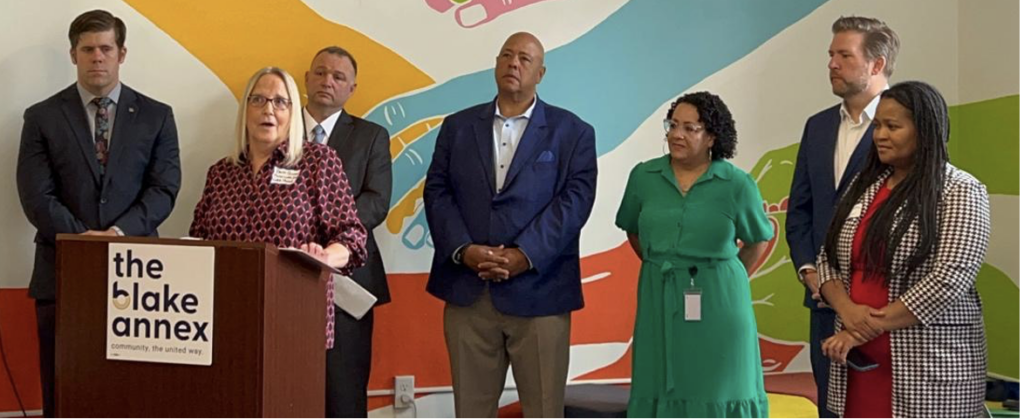
Peter Gannon, CEO of the United Way of the Greater Capital Region; Mike McLaughlin, Albany County Deputy County Executive; Paul Zuber, Executive Vice President of The Business Council of New York State; Justin Wilcox, Executive Director of Upstate United; Angelica Perez-Delgado, President & CEO of Ibero-American Action League, Rashida Tyler, Deputy Executive Director of the New York Council of Churches and Program Manager of the Interfaith Affordable Housing Collaborative, Beth Quinn, HR Supervisor and Career Counselor of Mirror Lake Inn.
The aim was to put leading civic voices at the center of the discussion, so that the issue of resettlement was seen not as a single-issue question facing the immigrant community, but instead was seen as a challenge and an opportunity for the whole community. The convenings made some real headway in broadening an understanding of the challenges and issues, and in identifying both sticking points and potential solutions. The main focal points that surfaced were:
- The glaring need for workers, and the urgent need to build a strong pipeline of workers-to-employers. Employers at each of the convenings stressed the need for expanding the local labor force. In Buffalo, Rochester, Syracuse, and Albany there was a strong awareness of the need to expand the overall labor force, and in the Hudson Valley there was particular interest from health care, hospitality, and construction sectors. Both business and labor leaders embraced the idea of expanding the labor force, and were eager to include new immigrants in jobs and job training. Labor leaders were eager to make sure it was possible for new immigrants to have a way to become union members, and creative approaches were considered about how to involve new immigrants in apprenticeship programs that build pathways to stable, living wages. Service providers in the community were already helping with job training, certification, and English language classes, but a key question remained about how to connect job seekers to open job opportunities as quickly as possible.
-
The importance of building local buy-in over resettlement of immigrants.
A named high priority challenge in every locale was the lack of coordination between New York City, which was “sending” immigrants to other parts of the state, and the local receiving communities. The initial experience was that the city was doing this without consultation, provoking a backlash and more than 30 counties “closing their doors” to potential new arrivals. At each of the convenings of the Ellis Island Initiative, participants stressed that they wanted to make resettlement work – but in a fashion that required respectful inclusion of the local communities from the start, with real resources.
The way the relocation was handled significantly shifted in the course of the year, in part because of the efforts of the Ellis Island Initiative and its partners. The meetings created an opportunity to take back the steering wheel so that leaders rooted in the community could help set a course for immigrant integration. In several areas – Albany, Watkins Glen, the Mid-Hudson Valley – local leadership councils were formed that advocated for welcoming the new arrivals and helping them to become established and thrive. New York City government began to recognize the importance of these local partners.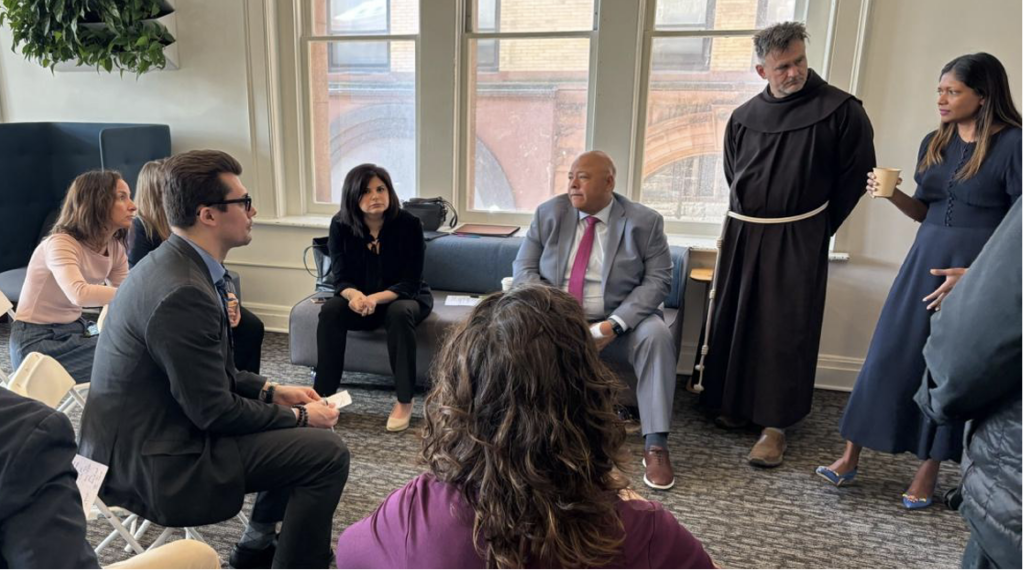
Rovika Rajkishun (right) Ellis Island Initiative Partnerships Specialist, leads discussion at a statewide convening held in Albany.
- The importance of changing the narrative around recent immigrants. A central theme that emerged across nearly every convening was the importance of changing the public narrative around recent immigrants. Participants—ranging from business leaders and labor organizers to elected officials and nonprofit directors—expressed concern that the prevailing portrayal of recent arrivals as a burden or threat was not only inaccurate, but dangerously counterproductive. Leaders voiced a shared commitment to shifting the tone of public discourse—from one of fear and resentment to one rooted in shared opportunity and mutual investment. They emphasized that immigrants were not “others” being imposed on communities, but new neighbors who, with the right support, could become vital contributors to local economies and civic life. Many participants also noted that negative media narratives and political attacks were not simply targeting migrants, but also undermining the identity and cohesion of communities long known for their hospitality, resilience, and diversity.
To push back against this trend, participants advocated for lifting up local stories of successful immigrant integration—highlighting newcomers finding work at small businesses, families being welcomed, and local employers who had come to depend on immigrant labor. They discussed the need for communications strategies rooted in local values, including patriotism, faith, family, and economic renewal, as well as the power of local voices—such as mayors, educators, union leaders, small business owners, and clergy—to speak authentically about why welcoming immigrants is in the community’s best interest. In several regions, participants even proposed local storytelling campaigns, public forums, or cultural events that could help reframe the conversation and reduce polarization. What became clear was that changing the narrative wasn’t an abstract communications goal—it was a precondition for long-term success in building inclusive, thriving communities.
These in-person, in-depth convenings played a critical role in building a strong foundation. Primarily made up of local non-immigrant leaders, these convenings demonstrated there was a base of local leaders who rejected the divisive rhetoric, were willing to come together across industry and partisan lines, and understood both the short- and long-term value of immigrants and recent arrivals to these upstate communities.
The Opportunities – and Challenges – in Changing the Narrative
The political context of 2024 was immensely challenging. The governor of Texas was paying for buses of immigrants to go from the border to New York City with the explicit intention of provoking a crisis and politicizing the issue. For some time, the mayor of New York City followed suit, sending buses with immigrants to upstate cities without advance planning or coordination. As a backdrop, the 2024 federal elections were getting underway, with immigration a central and divisive issue. This cocktail of explosive factors led to a consistent narrative of these recent arrivals as unvetted criminals, gang members and “child rapists” that posed a danger to upstate communities.
In the face of this onslaught, the Ellis Island Initiative used multiple strategies to help shift the narrative from “crisis” to one that recognizes the short-term investments that lead to long-term gains for everyone including the use of polling and data to create a fact-based narrative, publishing op-eds uplifting the support from local business and labor leaders, and the use of an ad campaign to widely spread the narrative among communities.
Use of Polling and Data to Craft a Compelling, Fact-Based Response
Ellis Island Initiative commissioned Hart Research to conduct two statewide opinion polls on these issues in October 2023 and in October 2024. The results showed that, statewide, an overwhelming number of likely voters saw the issue as a serious problem both in New York City and outside of New York City, a majority also saw it as a serious problem in their area specifically. The reality of public perception was that relatively few people saw the likely impact of the new immigrants as being positive. The poll did show some potential openings: 42 percent of people outside of New York City said they would like to see local leaders welcome migrants and help them integrate into their community. Asked the reasons for welcoming new immigrants, topping the list were employer demand for added workers (47 percent) and humanitarian concerns for immigrants who are turned away (44 percent). By contrast, the top concern voiced about immigrants was the cost to New York taxpayers.
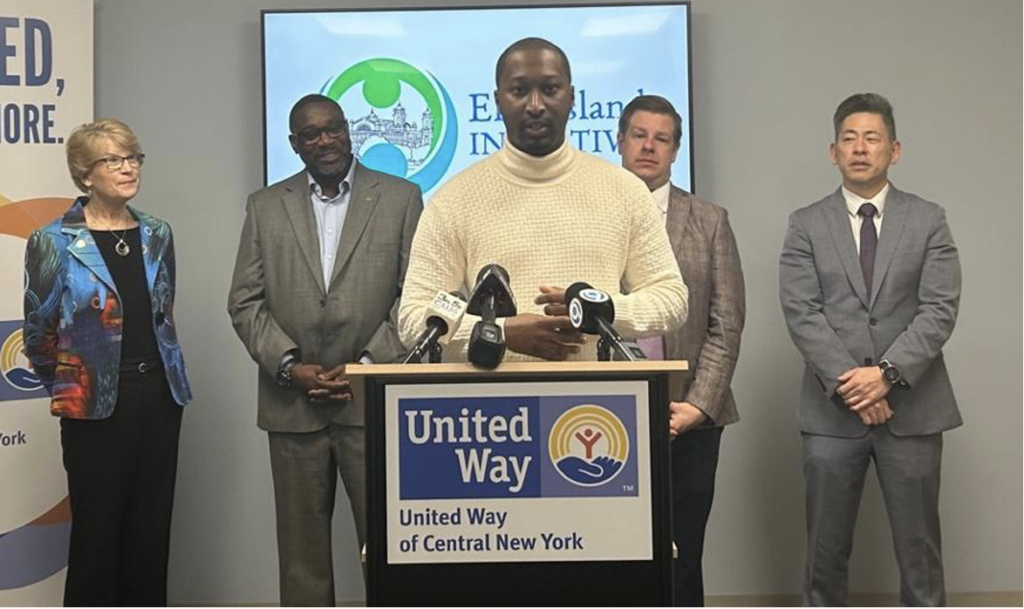
Nancy Eaton, President of the United Way of Central New York, Alexander Marion, Syracuse City Auditor, Kevin Lockhart, Vice President of 1199 SEIU of Central New York, Maurice Brown, Onondaga County Legislator, Steve Choi, Ellis Island Initiative.
To help reframe the narrative, the Ellis Island Initiative commissioned several reports with the Immigration Research Initiative. One report recognized the initial costs in helping people get resettled, but modeled the long run benefits, including significant increases in both earnings and tax revenues over time.
Another report laid out the particular reasons upstate cities with declining populations should welcome immigrants. In the report Immigrants in Buffalo: Plenty of Room for Growth, IRI showed a shrinking labor force in the region, and a growing population of people 65 and older, as well as the ways immigrants have typically become more fully integrated into the economy over time.
Giving Voice to Local Business, Labor and Elected Leaders
One of the remarkable successes—and lessons learned—was the ability of the Ellis Island Initiative to make an impact on local media. The Initiative helped place op-eds by business and labor leaders, usually writing together, to echo these points ran across the region. Op-eds included (see appendix for full list):
Mario Cilento, President of the NYS AFL-CIO and Heather Mulligan, President of the Business Council of New York State, In Immigration Wave, a Way to Expand New York’s Economy, Albany Times-Union, December 20, 2023.
Bob Duffy, President of the Greater Rochester Area Chamber of Commerce and former Lieutenant Governor, Rochester is Welcoming Immigrant Families—and Growing Our Economy, Rochester Democrat and Chronicle, May 9, 2024
Kevin Lockhard, Central New York area Vice President, 1199SEIU, and Kimberly Townsend, President & CEO of Loretto Healthcare, Migrants Offer a Way Out of Healthcare Crisis, Syracuse Post-Standard, June 12, 2024
Dottie Gallagher, President & CEO of the Buffalo Niagara Partnership and Peter DeJesus Jr., President of the Western New York Area Labor Federation, When New Immigrants Are Integrated Into Communities, the Economy Strengthens, Buffalo News, Sept. 24, 2024
Aside from opinion pieces, the very fact that Ellis Island Initiative was bringing together people across sectors to address the issue was itself newsworthy: each of the local meetings commanded significant television, radio, and newspaper coverage. The Ellis Island Initiative was referenced and quoted in multiple media outlets including Spectrum, Capitol Tonight, The Times Union, Newsday, and more. (For a full list of selected press clips, see Appendix B.)
The research that Ellis Island Initiative commissioned with the Immigration Research Initiative led to significant news coverage including:interviews on NY1 television, 1010 Wins drive time radio, Buffalo News editorial, Albany’s WAMC radio, Rochester’s WABC TV WROC TV, New York Newsday and joint op-eds by the director of Immigration Research Initiative with the director of Neighbors Link in LoHud, and the director of the Workers’ Center of Central New York in the Syracuse Post-Standard.
One of the key lessons learned was that there is tremendous opportunity in smaller media markets to have impact, particularly given the hollowing-out of local media in recent years. The Initiative’s ability to bring sophisticated, ready-made content – opinion pieces, articles, and events that lend themselves well to videos – virtually guaranteed placement in local print, TV, and radio media outlets.

Moving Communications to Advocacy
Ellis Island Initiative produced a powerful short video in October 2024, to lower the temperature of the issue during a heated presidential election. Enough political games around immigration, the video says, it’s time for common-sense local solutions. Our communities are ready to connect immigrants with open jobs and training, which helps us all. “Let’s get to work.” Again, the fact that Ellis Island Initiative represented a coalition of business, labor, and community leaders and was putting money behind the digital campaign was itself part of the story.
The context these efforts were up against was daunting. Gradually, however, a message of “crisis” and “burdens” was met by a counter-narrative that short-term investments lead to long-term gains, and that we have done this before and can do it again.Objections to a chaotic resettlement process were countered when a prominent group of local leaders stepped up to argue for pragmatic solutions. It would be hard to say the Ellis Island Initiative message won out, but it stopped the hemorrhaging on the issue and presented a clearly articulated alternative vision.
“Ready to Work”: Engaging Partners in A Statewide Advocacy Campaign
One of the key throughlines from the local and statewide convenings was the need for New York State to dedicate more resources for workforce development to create a “pipeline” of workers to employers that would be of benefit to local businesses while also making sure the jobs are good jobs with labor representation when possible and service providers who could help with social service needs. Ellis Island Initiative partners believed the combination of impending federal cutbacks to key workforce programs and the anti-immigration stance of the incoming administration would strangle the ability of local economies to attract, train, and retain new immigrant and untapped workers.
Ellis Island Initiative worked with its energized partners to launch a campaign, “Ready to Work,” craft a budget request that called for a $100 million investment to stabilize New York’s workforce and economy by connecting employers with underutilized and untapped workers to fill the state’s 500,000 current job openings. This funding would be utilized to increase support for workforce development and job training for populations that are underrepresented in the workforce – including recent immigrants – and include direct support for social service agencies and businesses for onboarding employees. Specifically, it calls for these investments:
- $50 million to support base WIOA Adult, Dislocated Worker, and Youth funding. These additional funds would be allocated to local workforce areas in the same manner as current programs supported by Federal Workforce Innovation and Opportunity Act (WIOA) and overseen by local workforce development boards. This additional funding would allow for services such as more individualized career advising for job seekers who have barriers to employment, support for individuals participating in occupational skills training programs, and on-the-job training grants for businesses.
- $50 million in enhanced supportive services (childcare, transportation, housing relocation, stipends for training programs, job placement navigators, language assistance) not generally funded by WIOA. This support would go to social service agencies, worker centers, workforce development entities, and local businesses to better guarantee that untapped and underutilized workers with barriers are provided a pathway to gainful employment.
The goal of this request was to mobilize our statewide set of partners to connect these workers – both recent immigrants and non-immigrant workers facing barriers – to the 500,000 jobs that sit unfilled, posing a serious obstacle to strong, robust local economies. The “Ready to Work” campaign was a key strategy that Ellis Island Initiative partners believed would help eradicate unnecessary barriers and connect employers with job seekers.
Given the anti-immigrant tenor of the November 2024 election results, Ellis Island Initiative partners initially recommended that we lean into messaging that lifted up the needs of businesses to attract and place untapped and underutilized workers rather than focusing on pro-immigration messages. As the Trump Administration began to roll out its anti-immigrant policies, we did find that Ellis Island Initiative partners became more forceful and confident to weave pro-immigration messaging and stances into the work. This was especially true in more historically conservative parts of the state, like the North Country, as illustrated by an op ed published by an Ellis Island Initiative partner, the Mirror Lake Inn in Lake Placid and a gathering of pro-immigrant business led by the Adirondack Regional Immigration Collaborative in Glens Falls.
The Ellis Island Initiative was able to secure commitments for the campaign from the chairs of the key Senate and Assembly Labor and Economic Development Committees, Senators Jessica Ramos and Sean Ryan and Assembly Members Harry Bronson and Al Stirpe, to push forward on this request. The Initiative worked with its broad set of partners to secure budget sign on letters, hold in-person and virtual meetings with 26 Assemblymembers and Senators, circulate a business-sign on letter that secured the support of 39 local business and trade organizations, met with staff and representatives from Hochul’s Administration, placed 5 local op-eds in key papers from around the state, and held an Advocacy Day in Albany in February to draw attention to this issue.
Although the Initiative was unsuccessful in terms of its budget request, Senator Jessica Ramos is committed to introducing legislation for the next legislative session that would codify the Ready to Work proposal into New York. The Initiative was also able to win an agreement from the Governor’s office to look for ways to develop pilot projects within key department budgets to support programs under the umbrella of its Ready to Work Initiative.
Even as we are approaching potential further austerity measures, driven by federal cutbacks, Ellis Island Initiative partners are in full agreement that this issue remains a critical issue, and that there still is an urgent need to push for the Ready to Work proposal in 2025-2026 as well. The Ready to Work efforts have also motivated local partners and workforce boards, like the Ulster County Workforce Board, to hold local convenings in late summer and fall to develop local strategies to take on the state’s worker shortage.
Lessons Learned
Several key insights have emerged from the Ellis Island Initiative’s work that can help shape future efforts to build broader public support for immigrant integration. These lessons underscore the importance of reaching beyond traditional allies to engage new messengers—particularly those with local credibility, economic influence, and civic standing—and demonstrate the complementary value of pragmatic, solutions-oriented organizing at a time of heightened polarization around the issue of immigration.
1. Local Mainstream Civic Leaders are an Untapped Resource
The Ellis Island Initiative, sought to fill a gap in organizing toward a bigger tent for positive immigration narrative, policy change, and advocacy. For many organizations in New York that focus on immigration, their mission is to organize their base of immigrant voices – and notably, there have been no intensive efforts to organize a base of non-immigrants (including businesses) in New York State before the Ellis Island Initiative. But the Initiative’s effort to ensure that businesses, business associations, labor, and civic leaders would be in the same room working toward common solutions was unique, and the results were far beyond expectations. The Ellis Island Initiative’s efforts to seek common ground served as a strong proof of concept, showing the potential for this kind of cross-sector effort. But it took the sustained attention of seasoned leaders at the Ellis Island Initiative to bring the local leaders together and keep them engaged. The Ellis Island Initiative shows enormous potential, but one that continues to require a sustained effort.
2. Creating a Counter-Narrative Is Difficult But Necessary
In an overheated atmosphere of 2024—with genuine challenges and a supercharged national media—advocates had a hard time turning around a destructive narrative about the increase in new immigrants. Some elements, however, made real inroads and established an alternative way to approach this challenge.
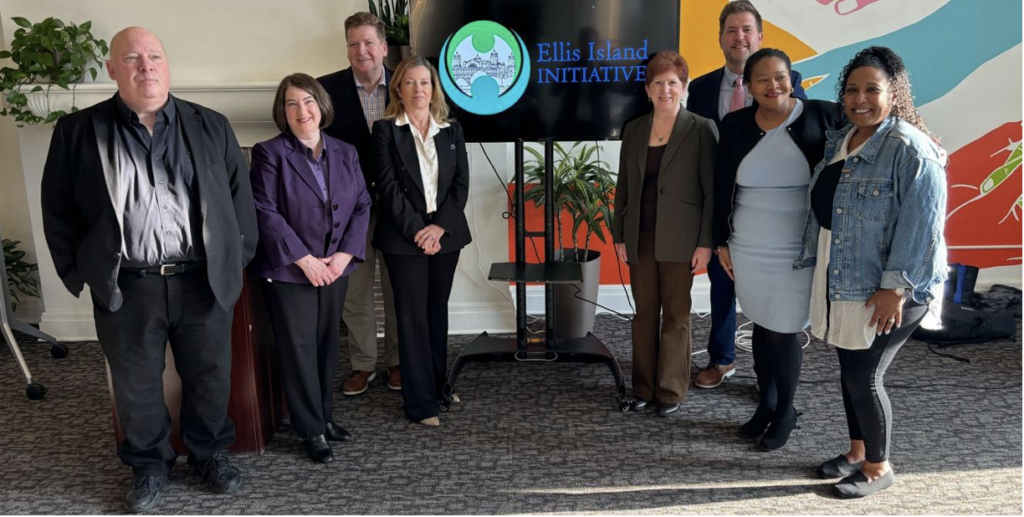
Mark Emanatian, Director of Capital District Area Labor Federation; Melissa Fleischut, President and CEO of The New York State Restaurant Association; Mark Eagan, President and CEO of the Capital Region Chamber; Heather Mulligan, President and CEO of The Business Council of New York State; Kathy Sheehan, Mayor of Albany; Peter Gannon, President and CEO of United Way of the Greater Capital Region; Rashida Tyler, Deputy Executive Director of the New York State Council of Churches; and Angela Lane, Vice President of 1199 SEIU.
There was positive feedback around the idea of a pragmatic, common-sense approach – utilizing poll-tested data – to thinking about new arrivals that is not driven by politics. Since the concerns were often local—about a strain on taxpayers or competition for services—it was helpful to have a localized analysis that showed the specific ways immigrants would fit into the economy and contribute to tax revenues. This was powerful in upstate cities, where an aging labor force can clearly benefit from an influx of working-age people. But it was also true in the downstate suburbs, where analysis showing specific sectors, such as health care, are particularly at risk. Finally, it was powerful for established local leaders to take ownership of the issue and say: we can manage this in an orderly way, and if we do it well, it will be good for our community. Addressing these economic and practical concerns also allowed the local leaders and the public to embrace the proud role the United States, and New York State in particular, have long played as a safe haven and welcoming place for new immigrants.
3. Businesses and Labor Can be Powerful Voices to Speak up for Immigrants
Going into the 2025 New York State budget season, the coalition convened by the Ellis Island Initiative were eager to issue a call for the state government to make a significant new investment that would facilitate the integration of new immigrants. The resulting “Ready to Work” campaign launched with a press conference on February 24, 2025, and called for a $100 million investment in workforce development and job training for groups of people who are underrepresented in the workforce—including but not limited to new immigrants—and to include direct support for social service agencies and business for onboarding employees. The presence of business leaders such as the Business Council of New York State, Upstate United, and the Business Council of Westchester all added a unique flavor to the campaign, as a groundbreaking effort to truly leverage businesses in advocacy efforts around immigrant workers. The Initiative’s successful efforts in engaging the business sector in particular in advocacy is, again, a proof of concept for the idea that it is possible to bring together business, labor and civic leaders in ways they have not typically come together around support for immigrant integration.
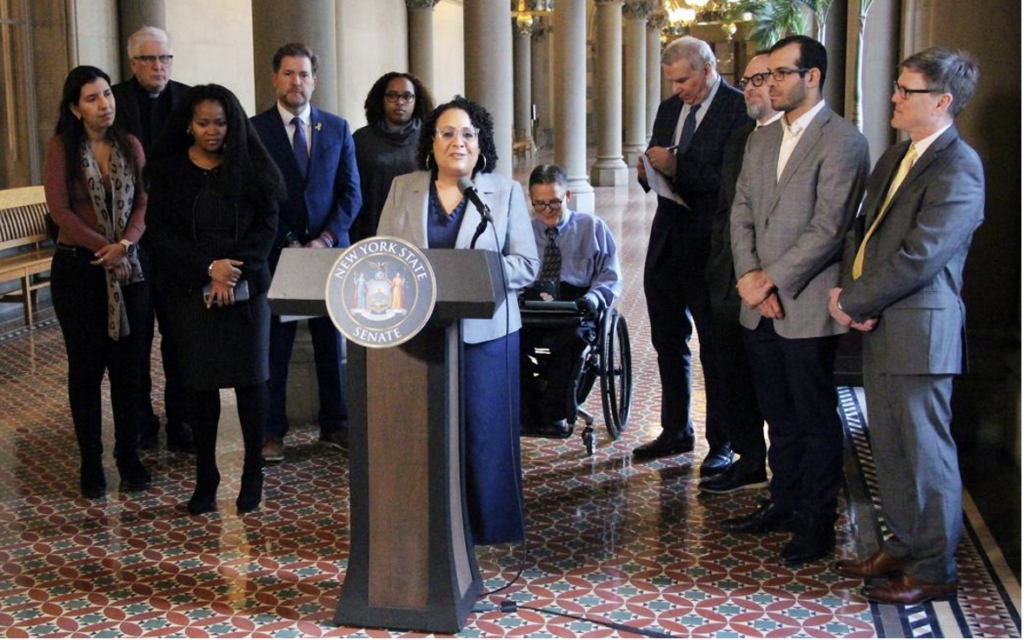
Ready to Work Advocacy Day February 26th, press conference moderated by Peter Gannon, CEO and President of the United Way of Albany and featured the Business Council of New York State, the New York City Employment & Training Coalition, the Business Council of Westchester, the New York State Council of Churches, Ibero-American Action League, Independent Living, Inc., and Dolphin Property Services, LLC.
Together, these lessons make clear that shifting the public conversation and building durable policy support for immigrant integration requires more than good messaging—it takes broad coalitions, shared economic interest, and trusted local voices. The Ellis Island Initiative provided a framework and field-tested approach that others can adapt and scale, especially in regions where immigration is seen as a challenge rather than an opportunity. Sustained engagement, cross-sector partnerships, and a commitment to local ownership are essential to carrying this work forward.